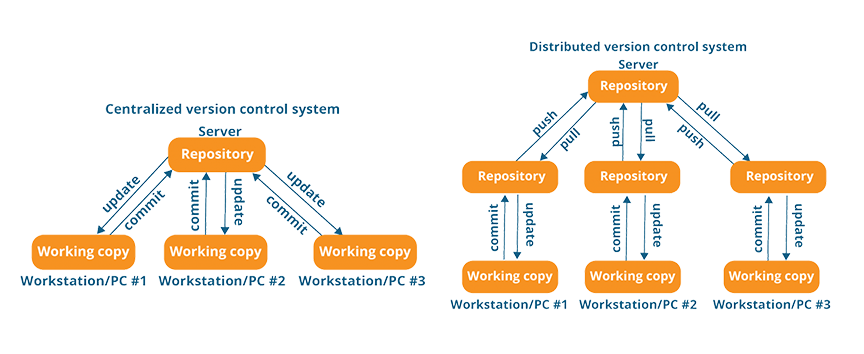Git is a free and open-source Distributed Version Control System (DVCS), a tool to manage your source code within a development team.
It was developed by Linus Torvalds in 2005 who is also the creator of the Linux kernel. Git was his second big project which came into existence to manage his first big project i.e. Linux kernel. This helped to manage the Linux kernel code changes done by a team of thousands of people.
It was developed by Linus Torvalds in 2005 who is also the creator of the Linux kernel. Git was his second big project which came into existence to manage his first big project i.e. Linux kernel. This helped to manage the Linux kernel code changes done by a team of thousands of people.
In a typical Centralized Version Control System (CVCS), the source code is maintained int the repository stored on a remote server. Git is termed as distributed because the source code repository is not only stored on the server but also stored on each development machine. The copy stored locally is called a local repository whereas the one stored on the server is called a server repository. Each developer can work on their local repository to commit (save) code changes locally. Once the changes are tested locally they can be merged into a server repository by performing a PUSH operation. Similarly, the latest code changes stored on the server can be fetched using a PULL operation.
To use Git on the command-line you will have to download, install and configure Git on your computer however Git is available out-of-the-box in Mac machines. The Windows version of Git is called GitBash.
Git is the most popular version control system and almost all IDEs support Git out-of-the-box so we generally don’t require to execute the Git commands manually, but there are instances where we need to run Git commands from the terminal console.
You can also see the list of all Git commands by executing git help -a
You can also see the list of all Git concepts by executing git help -g
Most commonly used Git commands are listed below:
usage: git [--version] [--help] [-C <path>] [-c <name>=<value>]
[--exec-path[=<path>]] [--html-path] [--man-path] [--info-path]
[-p | --paginate | --no-pager] [--no-replace-objects] [--bare]
[--git-dir=<path>] [--work-tree=<path>] [--namespace=<name>]
<command> [<args>]
Common Git commands are grouped together to use in different scenarios:
To start a working area:
clone Clone a repository into a new directory
init Create an empty Git repository or re-initialize an existing one
To work on the current change:
add Add file contents to the index
mv Move or rename a file, a directory, or a symlink
reset Reset current HEAD to the specified state
rm Remove files from the working tree and from the index
To examine the history and state:
bisect Use binary search to find the commit that introduced a bug
grep Print lines matching a pattern
log Show commit logs
show Show various types of objects
status Show the working tree status
To grow, mark and tweak your common history:
branch List, create or delete branches
checkout Switch branches or restore working tree files
commit Record changes to the repository
diff Show changes between commits, commit and working tree, etc
merge Join two or more development histories together
rebase Reapply commits on top of another base tip
tag Create, list, delete or verify a tag object signed with GPG
To collaborate:
fetch Download objects and refs from another repository
pull Fetch from and integrate with another repository or a local branch
push Update remote refs along with associated objects
See 'git help <command>' or 'git help <concept>' to read about a specific command or concept.
More on Git can be learnt from this article.

No comments:
Post a Comment